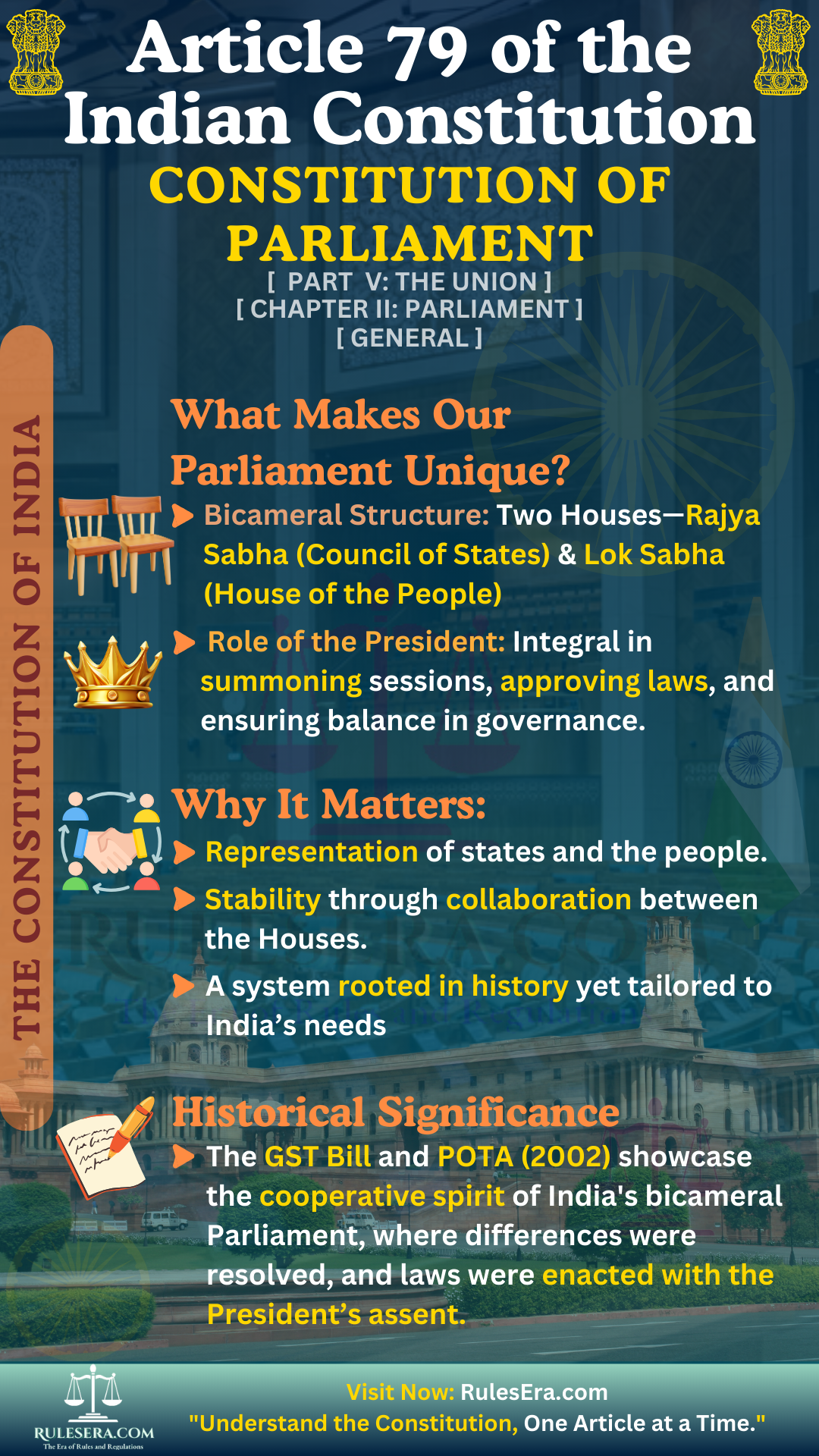Part V: The Union
Chapter II: Parliament
Article 79: Constitution of Parliament

--- Original Article ---
Original Article: There shall be a Parliament for the Union which shall consist of the President and two Houses to be known respectively as the Council of States and the House of the People.
Explanations
Article 79 is a cornerstone of India's legislative framework, establishing the structure of the Union Parliament. It highlights the bicameral nature of Parliament, comprising the President, the Council of States (Rajya Sabha), and the House of the People (Lok Sabha). This article delineates the composition and collaborative role of these entities within the Union government.
Key Points:
- Bicameral Structure of Parliament: The Indian Parliament is composed of two Houses, as stipulated in Article 79. The Council of States, also known as the Rajya Sabha, represents the states and Union Territories. The House of the People, or Lok Sabha, is composed of representatives directly elected by the citizens. Together with the President, they form a balanced structure where regional and national interests are represented.
- Collaborative Role of the President: Although not directly involved in the daily legislative process, the President plays a significant role in the functioning of Parliament. The President summons sessions, may address both Houses, and has the authority to dissolve the Lok Sabha. Additionally, no bill can become law without the President’s assent, signifying the President’s integral role in the legislative process.
Amendments and Historical Significance
The structure of Parliament outlined in Article 79 draws from historical practices observed in British governance but has been tailored to suit India's federal needs. The composition reflects the idea that both regional and national voices should shape the Union’s legislation. Since its inception, the article has not been amended, underscoring its enduring relevance in India's governance framework.
Real-Life Example
- A key instance illustrating the President's role was in 2002 when the Prevention of Terrorism Act (POTA) was passed in a joint sitting due to differing opinions in the two Houses. Following this, the bill required the President’s assent to become law.
- The relationship between the Rajya Sabha and Lok Sabha was especially highlighted during the passage of landmark bills such as the GST Bill. After debates and consultations in both houses, the bill was presented to the President for assent, marking the final step before its implementation across India.
Legislative History
Article 79 of the Indian Constitution traces its origins to Article 66 of the Draft Constitution, which was thoroughly debated on January 3, 1949.
Debates and Deliberations
During the debate in the Constituent Assembly regarding Article 79 (Draft Article 66), Shri Lokanath Misra proposed eliminating the Council of States from the Draft Constitution, advocating for a unicameral Parliament. He argued that a second chamber is outdated, unnecessary, and would not provide a moderating effect on legislation. Misra highlighted that without aligning the upper house with Indian cultural values, it would be a waste of resources, citing Orissa's decision to adopt a single-chamber system as a positive example.
Begum Aizaz Rasul proposed renaming the Union Legislature as the "Indian National Congress" to honor the Congress's role in India's freedom struggle. She argued this would commemorate the Congress's legacy, prevent its emotional influence on voters, and distinguish it from its potential future degeneration as a political party. Rasul suggested that adopting this name, akin to the American Congress, would reflect the ideals of the Indian National Congress.
Prof. K. T. Shah proposed removing the President from Article 66, arguing that unlike the British King, who holds significant powers and is integral to Parliament, the Indian President is merely a figurehead acting on ministerial advice. He contended that this imitation of the British system is unnecessary and inappropriate for India’s new Constitution, which should reflect its unique governance structure without conflating the President with legislative authority.
Shri M. Ananthasayanam Ayyangar opposed all the proposed amendments. He argued that the Upper House is essential for providing more political opportunities, acting as a check on hasty legislation, and offering stability as a permanent body. Regarding the renaming of Parliament, Ayyangar acknowledged the Congress's role in India's freedom struggle but cautioned that associating its name with Parliament could lead to perceptions of one-party rule and hinder the Congress's political function. He also defended retaining the President as part of Parliament, citing the President's critical role as the executive authority per Draft Article 42, and emphasized that this is not merely an imitation of British practices but a necessary inclusion in India's constitutional framework.
Following the rejection of all proposed amendments, the original draft of Article 66 was incorporated into the final text of the Indian Constitution.
Frequently Asked Questions (FAQs):
Article 79 establishes the bicameral structure of Parliament, consisting of the President, the Council of States (Rajya Sabha), and the House of the People (Lok Sabha).
No, Article 79 has not been amended since its inception in the original Constitution of India.